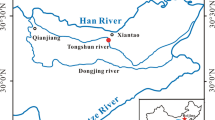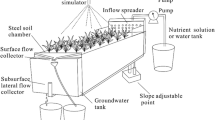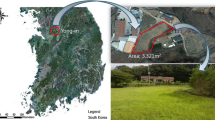Abstract
In recent years, nonpoint source pollutions, caused mostly by surface runoff, have become a subject of interest. Vegetative buffer strips contain a special plant species being passed by the flow before getting into the water bodies. The main aim of the present study is to evaluate the impact of three different types of vegetative buffer strips to reduce the surface water pollutants including sediment, nitrate and phosphate. The experiments were carried out using the experimental plots with the dimension of 1 × 10 m2 as well as the artificial runoff with a flow rate of 1.65 L s−1 during a year. The results of this study showed that the vegetative buffer strips reduced the runoff volume by 35–90%, sediment concentration by 42–94%, nitrate concentration by 35–88% and phosphate concentration by 28–95%. According to the results, the vetiver grass has a high efficiency in runoff pollutants control; but, due to the probability of creating the concentrated flow among the bushes of vetiver grass, it is strongly recommended to use a resistant plant with a density and uniformity similar to the turf grass and consistent to climatic conditions of the study area along with the vetiver grass. Also, periodic cutting the plants is as an effective strategy to deal with the role of vegetative buffer strips as a source of nutrients and sediment.








Similar content being viewed by others
Notes
Best Management Practices.
Vegetative Buffer Strips.
Total Suspended Solids.
References
Abdollahi Z, Kavian A, Sadeghi SHR (2017) Spatio-temporal changes of water quality variables in a highly disturbed river. Global J Environ Sci Manage 3(3):243–256
Barling RD (1994) Role of buffer strips in management of waterway pollution: a review. Environ Manag 18(4):543–558
Bhattarai R, Kalita PK, Patel MK (2009) Nutrient transport through vegetative filter strip with subsurface drainage. J Environ Manag 90:1868–1876
Borin M, Passoni M, Thiene M, Tempesta T (2010) Multiple functions of buffer strips in farming areas. Eur J Agron 32:103–111
Borina M, Vianelloa M, Moraria F, Zaninb G (2005) Effectiveness of buffer strips in removing pollutants in runoff from a cultivated field in North-East Italy. Agric Ecosyst Environ 105:101–114
Campo-Bescos MA, Munoz-Carpena R, Kiker GA, Bodah BW, Ullman JL (2015) Watering or buffering? Runoff and sediment pollution control from furrow irrigated fields in arid environments. Agric Ecosyst Environ 205:90–101
Cheng B, Hu CW, Zhao YJ (2011) Effects of plants development and pollutant loading on performance of vertical subsurface flow constructed wetlands. Int J Environ Sci Technol 8(1):177–186
Chimwanza B, Mumba PP, Moyo BHZ, Kadewa W (2006) The impact of farming on river banks on water quality of the rivers. Int J Environ Sci Technol 2(4):353–358
Dabney SM (2003) Erosion control, vegetative. Encyclopaedia of water science. Marcel Dekker, New York
Delgado AN, Periago EL, Viqueira FD (1995) Vegetated filter strips for wastewater purification: a review. Biores Technol 51:13–22
Dindaroglu T, Reis M, Akay AE, Tonguç F (2015) Hydroecological approach for determining the width of riparian buffer zones for providing soil conservation and water quality. Int J Environ Sci Technol 12(1):275–284
Duchemin M, Hogue R (2009) Reduction in agricultural non-point source pollution in the first year following establishment of an integrated grass/tree filter strip system in southern Quebec (Canada). Agr Ecosyst Environ 131:85–97
Golabi MH, Iyekar C, Minton D, Raulerson CL, Drake JC (2005) Watershed management to meet water quality standards by using the vetiver system in Southern Guam. Aust J Technol 9(1):63–70
Hay V, Pittroff W, Tooman EE, Meyer D (2006) Effectiveness of vegetative filter strips in attenuating nutrient and sediment runoff from irrigated pastures. J Agric Sci 144:349–360
Hong Q, Sun Z, Chen Z, Liu R, Shen Z (2012) Small-scale watershed extended method for non-point source pollution estimation in part of the Three Gorges Reservoir Region. Int J Environ Sci Technol 9(4):595–604
Hussein J, Yu B, Ghadiri H, Rose C (2007) Prediction of surface flow hydrology and sediment retention upslope of a vetiver buffer strip. J Hydrol 338:261–272
Imandoust SB, Gadam SN (2007) Are people willing to pay for river water quality, contingent valuation. Int J Environ Sci Technol 4(3):401–408
Iranian association for Vetiver Promotion (2008) Vetiver system to prevent and treatment of chemical pollutions of water and soil (In Farsi)
Kavian A, Azmoodeh A, Solaimani K (2014) Deforestation effects on soil properties, runoff and erosion in northern Iran. Arab J Geosci 7(5):1941–1950
Kavian A, Sabet SH, Solaimani K, Jafari B (2017) Simulating the effects of land use changes on soil erosion using RUSLE model. Geocarto Int 32(1):97–111
Kelarestaghi A, Ahmadi H, Esmaeili Ouri A, Ghodusi J (2008) Comparison of runoff and sediment production in various agricultural landuse treatments. Iran Watershed Manag Sci Eng 2(5):41–52 (In Farsi)
Lam QD, Schmalz B, Fohrer N (2011) The impact of agricultural best management practices on water quality in a North German lowland catchment. Environ Monit 183:351–379
Lee K-H, Isenhart TM, Schultz RC, Mickelson KS (1999) Nutrient and sediment removal by switchgrass and cool-season filter strips in Central Iowa, USA. Agrofor Syst 44:121–132
Lee KH, Isenhart TM, Schultz RC (2003) Sediment and nutrient removal in an established multi-species riparian buffer. J Soil Water Conserv 58(1):1–8
Mankin KR, Daniel MN, Charles JB, Stacy LH, Wayne AG (2007) Grass-shrub riparian buffer removal of sediment, phosphorus, and nitrogen from simulated runoff. J Am Water Resour Assoc 43(5):1108–1116
Milan M, Ferrero A, Letey M, De Palo F, Vidotto F (2014) Effect of buffer strips and soil texture on runoff losses of flufenacet and isoxaflutole from maize fields. J Environ Sci Health Part B 48:1021–1033
Mohammadi MA, Kavian A (2015) Effects of rainfall patterns on runoff and soil erosion in field plots. Int Soil Water Conserv Res 3(4):273–281
Norris V (1993) The use of buffer zones to protect water quality: a review. Water Resour Manag 7:257–272
Osborne LL, Kovacic DA (1993) Riparian vegetated buffer strips in water-quality restoration and stream management. Freshmler Biol 29:243–258
Otto S, Vianello M, Infantino A, Zanin G, Di Guardo A (2008) Effect of a full-grown vegetative filter strip on herbicide runoff: maintaining of filter capacity over time. Chemosphere 71:74–82
Otto S, Cardinali A, Marotta E, Paradisi C, Zanin G (2012) Effect of vegetative filter strips on herbicide runoff under various types of rainfall. Chemosphere 88:113–119
Patty L, Real B, Gril J (1997) The use of grassed buffer strips to remove pesticides, nitrate and soluble phosphorus compounds from runoff water. Pestic Sci 49:243–251
Sadeghi Ravesh MH (2011) Comparison of human thermal comfort amount in arid and humid climates (Case study: Yazd and Sari cities). Arid Biom Sci Res J 1(2):50–61 (In Farsi)
Safari A, Kavian A, Parsakhoo A, Saleh I, Jordán A (2016) Impact of different parts of skid trails on runoff and soil erosion in the Hyrcanian forest (northern Iran). Geoderma 263:161–167
Shooshtarian S, Tehranifar A (2011) Introducing the vetiver grass and its properties. Iran Agricultural Science Publications
SPSS Inc. (2009). PASW Statistics for OSX, Version 18.0. SPSS Inc., Chicago
Stutter M, Langan S, Lumsdon A (2009) Vegetated buffer strips can lead to increased release of phosphorus to waters: a biogeochemical assessment of the mechanisms. Environ Sci Technol 43:1858–1863
Wakida FT, Martinez-Huato S, Garcia-Flores E, Piñon-Colin TDG, Espinoza-Gomez H, Ames-López A (2014) Pollutant association with suspended solids in stormwater in Tijuana, Mexico. Int J Environ Sci Technol 11(2):319–326
Wang L, Duggin J, Nie D (2012) Nitrateenitrogen reduction by established tree and pasture buffer strips associated with a cattle feedlot effluent disposal area near Armidale, NSW Australia. J Environ Manag 99:1–9
Acknowledgements
The authors thank Sari Agricultural Sciences and Natural Resources University (SANRU) for providing a part of funds to conduct the present research. Also, we would like to thank the anonymous reviewers as well as the editor for their invaluable comments.
Author information
Authors and Affiliations
Corresponding author
Additional information
Editorial responsibility: Tan Yigitcanlar.
Rights and permissions
About this article
Cite this article
Saleh, I., Kavian, A., Habibnezhad Roushan, M. et al. The efficiency of vegetative buffer strips in runoff quality and quantity control. Int. J. Environ. Sci. Technol. 15, 811–820 (2018). https://doi.org/10.1007/s13762-017-1411-2
Received:
Revised:
Accepted:
Published:
Issue Date:
DOI: https://doi.org/10.1007/s13762-017-1411-2




